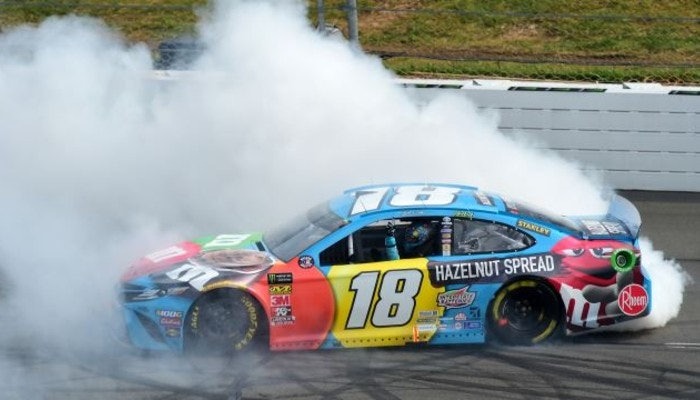Do you have questions about betting on NASCAR now that the 2021 season is about to start? Are you wondering what NASCAR “handicapping” entails?
Here are the basics. If you pick a driver to win because you like the paint job on his car… you are NOT handicapping. You are going with a fun, gut-feeling, emotional pick. That’s perfect for many people getting their feet wet. Think of it as picking a Kentucky Derby winner because of their name!
Here are the Best Sports Betting Sites for 2021
But, if you do any research, of any kind, then you are handicapping sports. It’s that simple! Handicapping means that some research has been done before placing a wager. It does not have to be complicated! Your research could be as simple or as in-depth as you care to make it.
Are you looking to move past the point of picking a driver because you like the design of their car’s paint job? There are plenty of stats to research for drivers, manufactures, tracks, and more – here are some of the basic stats to consider with a few pro and cons.
Driver Wins – Driver Wins at Track
This one is a given – one of the first stats people look at is how many wins a driver has in their career, during a season, and at a track. That’s a great way to get a quick grasp of how a driver has performed in the past.
Sounds simple, but it can get complicated. A driver could have racked up wins at a certain track in the Camping World Truck Series but never come close in the Cup Series. Or, like what happened to Jimmie Johnson before he retired.
For example, Jimmie Johnson won at Martinsville nine times in his Cup Series career. However, before his last full-time season – last year – his last win there came in 2016. Before that, it was in 2013. So, the bulk of his wins came earlier in his career.
Team/Owner Stats at a Track
This stat may be as important as how a driver has performed at a track. The latest example comes from the 2020 season last year. Ford drivers won 18 races during the season. In 2019 it was Toyota that put up 19 wins to capture the manufacture title.
One of the best examples to point towards is Talladega Superspeedway. Races at ‘Dega are often called a toss-up due to large wrecks that can eliminate multiple cars. The thought being “anyone can win at ‘Dega” during a race.
If that’s true – then Ford drivers have missed a bunch of wrecks! In the last twelve Cup Series races at the track, Ford has won nine of them.
2021 NASCAR Championship Futures Odds and Picks
Average Finish
You can now dive into other stats once you get past the shiny objects of wins by driver and manufacture. A perfect place to start is by looking at the Average Finish for drivers you are considering.
The average finish can be broken down the same way as mentioned above. Average finish stats can be found for a driver for a career, for a year, at a certain track, etc.
Like other information, the average finish stat can be skewed. A driver could have three top-five finishes during the last three races at a track but have three races prior where they also ran well but were caught up in a wreck towards the end of the race.
When wagering on a race, you’ll probably focus on a driver’s average finish at the track where the race is being held. But, never discount what the driver’s average finish is during the current season.
Average Running Position on a Led Lap
The stat for average running position gives you a snapshot of where the driver was during an entire race while on the lead lap. They may finish first, but before the final lap, they may have been riding near the front or towards the middle of the field.
This stat allows you to focus on a driver’s average place on the scoring tower at a certain track. Meaning, your driver may have never won at Daytona but they have an average running position of tenth. That’s a pretty good stat.
That great number of tenth I used as an example will probably be for a small sample size such as the last two or three races. If you add more races from years past then that number will probably rise.
Expert Guide Teaching You How to Bet on NASCAR
Laps Led at Track
Checking a driver’s laps led stat at a track is a great way to cut through some of the fog created by other stats. You can look at the average finish and running position stats and think a driver is not too good at the track. But, they may have an incredible number of laps led!
That means that driver was probably running great – as in the front spot – until something happened. They may have run out of gas, blown a tire, lost positions in the pits, suffered a penalty, etc.
Fastest Lap
This is a nice stat to consider as it simply determines which driver had the fastest lap, or laps, on the track during any given moment in a race. You may see this mentioned several times during the ending of a race when announcers start comparing lap times between drivers.
The upside is that a glance at these stats can tell you if a driver you are considering has run a whole bunch of fast laps at a certain track.
Driver Rankings
The Driver Ranking numbers compiled by NASCAR for each driver is probably the one stat that is often overlooked. At the same time, it probably should be the first stat to consider! Driver Ranking combines a whole bunch of stats in one easy number that tops out at 150 points. A driver with a 142 number has run better at a track than a driver sporting a 99.
Here’s why this stat is AWESOME! Driver ranking combines the stats mentioned above (Win, Finish, Running Position, Laps Led, and Fastest Lap) as well as the following stats: Top-15 Finish, Average Average Speed Under Green, Fastest Lap, and Lead-Lap Finish.
Daytona 500 Betting Trends, Statistics and Tips
Things you HAVE to Consider when Handicapping NASCAR
The best way to close this article is to point out something many casual fans of NASCAR may not realize. Even though the cars have looked the same over the last years – shiny, pretty colors, and fast – they have changed a lot!
NASCAR, as a sanctioning body, mandates changes to the cars every season, during the season, and from year to year. The reason for this ranges from safety innovations to better areo features. And, this is done for all three manufactures.
The cars on the tracks this season are different from the cars on the track last season and even more so than cars used three, five, ten years ago. Why is this important? Because if you go too far back in your research you may be factoring in useless data. A driver that mastered Talledega in a 2016 – 2017 Cup Series car may have fallen off after certain changes were made.
Long story short, do your research! Stats matter! But make sure you keep your number samples current. I look back to the last few seasons. And, that may change after this year. The newest generation of the NASCAR Cup Series base car will take to the track in 2022 which means everything may change.

